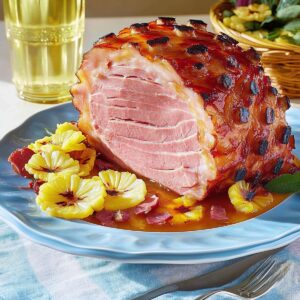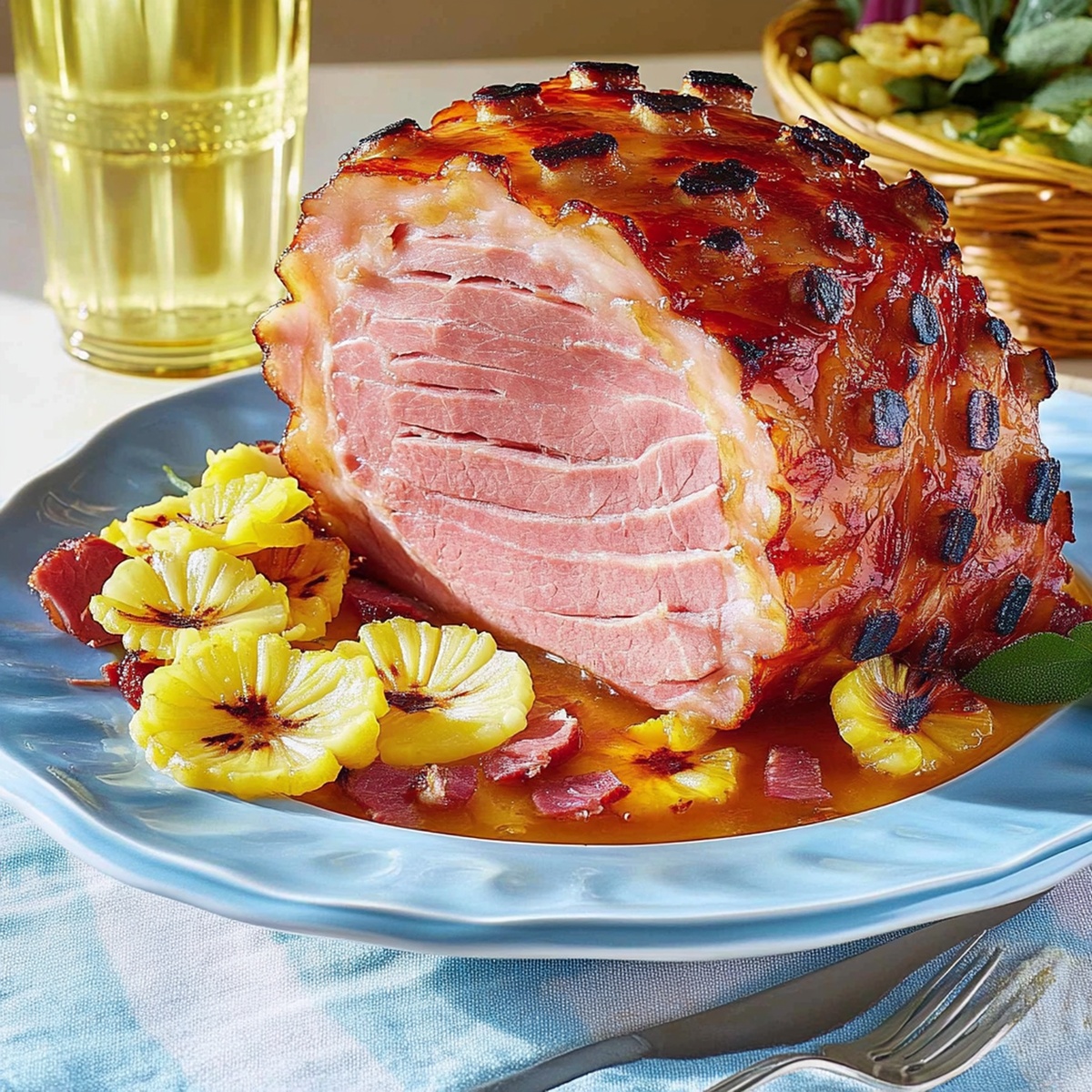Juicy Easter Ham on the Grill: A Smoky-Sweet Holiday Recipe
Tucking into a succulent Easter ham with smoky grilled notes can transform an ordinary meal into a memorable feast.
Families gather around the table, anticipating the rich, caramelized flavors that emerge from careful preparation.
Tender meat kissed by grill marks promises a delightful centerpiece for your holiday celebration.
Marinades and glazes enhance the natural sweetness of premium pork, creating layers of complexity.
Seasonal herbs and subtle spices complement the ham robust character, making each slice a culinary delight.
Simple techniques ensure you achieve perfectly grilled results that will impress everyone at the table.
Let’s unlock the secrets to a mouthwatering ham that turns your Easter gathering into an unforgettable dining experience.
Grilled Easter Ham Centerpiece Celebration
Grilled Easter Ham Ingredient Checklist
Main Protein:Glaze Ingredients:Preparation Ingredient:Grilled Easter Ham Grill Master Steps
Step 1: Fire Up the Grill
Get your grill ready by setting it to a cozy medium heat around 350°F (175°C).
This warm temperature will help cook your ham evenly without burning.
Step 2: Whip Up the Glorious Glaze
Grab a mixing bowl and combine:Stir everything until the mixture becomes smooth and glossy, creating a mouthwatering coating for your ham.
Step 3: Create Beautiful Diamond Cuts
Use a sharp knife to score the ham’s surface, making elegant diamond-shaped patterns.
These cuts will help the glaze penetrate deeply and create a stunning presentation.
Step 4: Lavish with Glaze
Take your prepared glaze and generously brush it all over the scored ham.
Make sure every nook and cranny gets a delicious coating.
Step 5: Grill with Patience
Place the ham on the grill, positioning it away from direct heat.
Close the grill lid and let it cook for approximately two hours.
Every 30 minutes, baste the ham with the remaining glaze to keep it moist and flavorful.
Step 6: Check for Perfect Doneness
Use a meat thermometer to verify the internal temperature.
The ham should reach at least 140°F (60°C) before you remove it from the grill.
This ensures it’s safely cooked and wonderfully tender.
Pro Tips for Juicy Grilled Easter Ham
Storing and Reheating Grilled Easter Ham
Delicious Pairings for Grilled Easter Ham
Flavorful Variations on Grilled Easter Ham
FAQs
Absolutely! While Dijon mustard adds a tangy flavor, you can substitute with whole grain mustard or honey mustard for a slightly different taste profile.
No, you can leave the skin on. Scoring the surface helps the glaze penetrate and creates an appealing presentation while keeping the meat moist.
Basting every 30 minutes with the glaze and cooking over indirect heat helps maintain moisture. Keep the grill lid closed to trap heat and prevent the ham from becoming too dry.
Yes, you can mix the brown sugar, Dijon mustard, and pineapple juice up to 24 hours ahead and store it in the refrigerator until you’re ready to use it on the ham.
Print
Grilled Easter Ham Recipe
- Total Time: 2 hours 15 minutes
- Yield: 12 1x
Description
Savory Easter ham sparkles with honey-glazed perfection, bringing classic holiday flavors to your festive table. Juicy slices and caramelized edges invite you to savor each delectable bite of this traditional centerpiece celebration.
Ingredients
Main Protein:
- 8–12 pounds bone-in ham
Glaze Ingredients:
- 1 cup brown sugar
- 1/2 cup dijon mustard
- 1/4 cup pineapple juice
Aromatic Ingredient:
- 3 cinnamon sticks
Instructions
- Prepare the outdoor grill, establishing a consistent medium temperature around 350F (175C) for even cooking.
- Create a vibrant glaze by whisking brown sugar, Dijon mustard, and pineapple juice until achieving a silky, uniform consistency.
- Transform the ham’s exterior by carving intersecting diagonal lines across its surface, forming an elegant diamond-patterned texture.
- Lavishly coat the scored ham with the prepared glaze, ensuring comprehensive coverage across all textured surfaces.
- Position the ham on the grill’s indirect heat zone, sheltered from direct flames, and seal the grill’s lid to maintain consistent temperature.
- Allow the ham to roast undisturbed for approximately two hours, periodically refreshing its glaze every half-hour to enhance moisture and flavor.
- Monitor the internal temperature using a meat thermometer; ham requires reaching a minimum of 140F (60C) to guarantee safe consumption.
- Once temperature criteria are met, carefully remove the ham from the grill, letting it rest momentarily before slicing and serving.
Notes
- Scoring the ham creates beautiful diamond patterns that help the glaze penetrate and caramelize, enhancing both visual appeal and flavor absorption.
- When grilling, position the ham indirectly to prevent burning and ensure even cooking, maintaining moisture and preventing charred exterior.
- Use a meat thermometer to guarantee precise doneness, preventing overcooking that could dry out the ham and compromising its tenderness.
- For dietary variations, substitute pineapple juice with orange juice or apple cider for different flavor profiles while maintaining a similar sweet-tangy glaze consistency.
- Prep Time: 15 minutes
- Cook Time: 2 hours
- Category: Dinner, Appetizer
- Method: Grilling
- Cuisine: American
Nutrition
- Serving Size: 12
- Calories: 202
- Sugar: 8 g
- Sodium: 800 mg
- Fat: 6 g
- Saturated Fat: 2 g
- Unsaturated Fat: 4 g
- Trans Fat: 0 g
- Carbohydrates: 12 g
- Fiber: 0 g
- Protein: 25 g
- Cholesterol: 70 mg


Jack Sullivan
Founder & Culinary Storyteller
Expertise
Single-recipe development with a narrative approach, Culinary storytelling and food history, Seasonal and regional ingredient utilization, Home cooking techniques adapted for modern kitchens
Education
New England Culinary Institute (Montpelier, VT)
Certificate in Culinary Arts
Focused on farm-to-table cooking, sustainable practices, and modern plating techniques.
Asheville-Buncombe Technical Community College
Associate Degree in Culinary Arts
Emphasized Southern Appalachian cuisine and local ingredient sourcing.
Jack grew up surrounded by smoky skillets and handwritten recipes in the mountains of North Carolina. His roots in Appalachian cooking shaped the way he sees food – as something that connects people, tells a story, and holds meaning.
With hands-on training and a background in sustainable, regional cooking, Jack started Boil And Broil to make meaningful meals more accessible. He’s all about one-dish recipes that are simple to follow but rich with flavor and history.